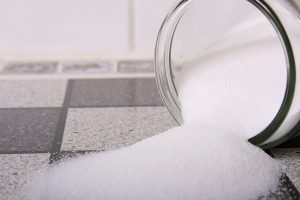 It’s a fact. We need salt in our diets. Our bodies need sodium, which we usually get through salt, to maintain fluid balance and blood volume. Unfortunately, most of us consume at least twice as much sodium as we need.
It’s a fact. We need salt in our diets. Our bodies need sodium, which we usually get through salt, to maintain fluid balance and blood volume. Unfortunately, most of us consume at least twice as much sodium as we need.
The main culprit for sodium intake is not the salt we sprinkle on food, nor is it the salt we use when we cook. It’s the processed foods we grab to make meal preparation quicker and easier – the breads, soups, pizza, cheese, snacks, and more. For example, most of us require only 1,500 mg of sodium, or ¾ teaspoon, per day. Just one slice of a typical frozen pizza contains more than half that amount.
It’s a good idea to buy fresh, frozen, or low sodium veggies, choose roasted meats over processed lunch meats, and read labels to find low sodium choices when possible. How do you know your item is low sodium? It should contain 140 mg or less of sodium per typical serving. If that’s hard to remember, just look for foods with a Daily Value (DV) of 5% or less.
Soup is one of the worst offenders when it comes to sodium content. Unfortunately, when commercial soups are cooked at a high temperature long enough to kill potentially harmful bacteria, the soups lose some of their flavor. Salt offers a cheap and easy way to make up for that loss. Still, many soups can be a great choice, especially if you’re counting calories. How can you enjoy a quick cup of soup without loading up on the salt? Start with a can of light or reduced sodium soup then add your favorite fresh or unseasoned frozen veggies. You’ll still get more sodium than you would with homemade soup but you’ll get much less than in typical canned soup, with an added nutrient and fiber boost.
With a few changes, you can reduce your sodium and still enjoy tasty meals!
References:
University of Florida IFAS Extension, Keeping the Pressure Down, Lesson 4: DASH Diet – Balancing Minerals.
Dahl W & Foster L. Shopping for Health: Sodium
Nutrition Action, Do You Want to Discover Ways to Cut Salt from Your Diet? 10/17/2016
 0
0
